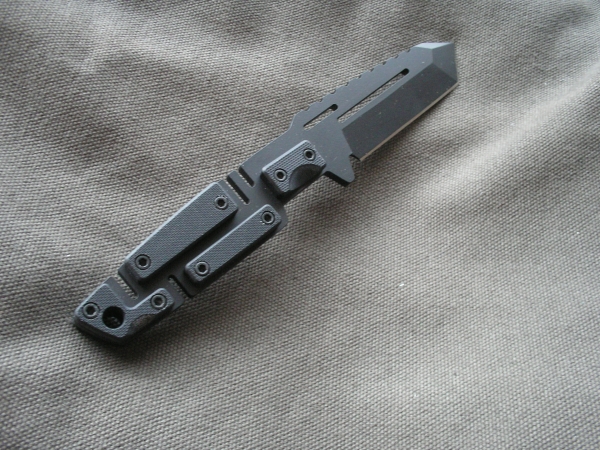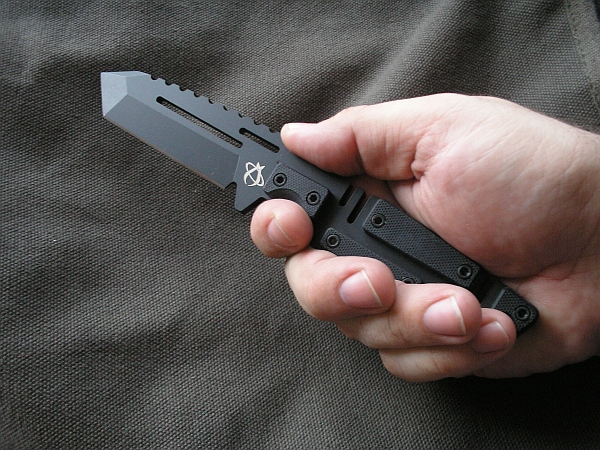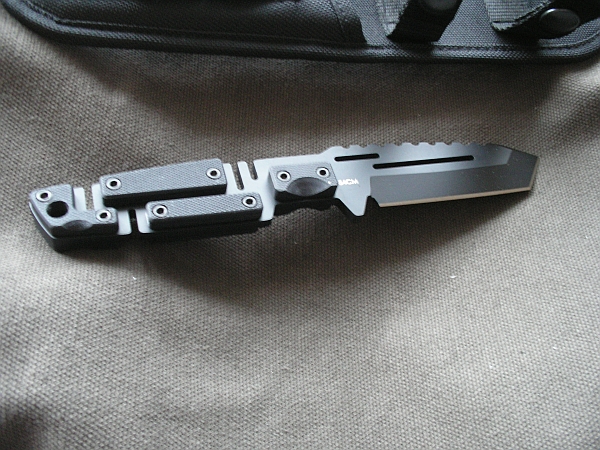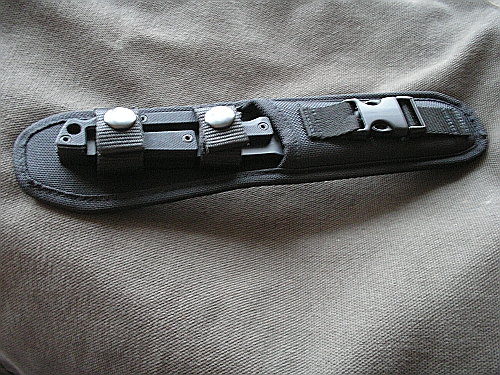Mantis Knives MF4HC and MF4CM
Review by Phil Elmore
It was in early 2007 when The Martialist first took note of Mantis Knives, a brand that seemed to appear out of nowhere in dealer catalogs and knife magazine advertisements. Contacting a real, live human being through the company's website proved surprisingly easy. We are therefore happy, after a year of living and working with these knives, to present long-term reviews of this company's blades.
 According to Jared West, owner of Mantis Knives, the company was
founded in late 2005 and debuted at the 2006 SHOT Show. "The
Mantis Logo came to me before the name did," Jared told me. "I
was sitting in an International Business class at the Hilton Business
School at L.M.U. in 2001. I was taking notes, and this logo just
hit me, so I scribbled it down. I revised it a couple of
times. Now it's the logo that you see on every Mantis Knives box
that ships out of our Anaheim Hills headquarters."
According to Jared West, owner of Mantis Knives, the company was
founded in late 2005 and debuted at the 2006 SHOT Show. "The
Mantis Logo came to me before the name did," Jared told me. "I
was sitting in an International Business class at the Hilton Business
School at L.M.U. in 2001. I was taking notes, and this logo just
hit me, so I scribbled it down. I revised it a couple of
times. Now it's the logo that you see on every Mantis Knives box
that ships out of our Anaheim Hills headquarters."
That headquarters is a 10,000 square foot facility in Orange County,
California. Some of the knives in the Mantis line are made in the
United States, while others are assembled in Taiwan from US-made
materials (sent by Mantis from Crucible and other sources). The
result is a line of affordable knives of decent quality for the money,
including the only brand of knives officially sanctioned by the United
States Catfish Anglers Tournament Series. "We're the only company
they endorse," Jared states. "We're [also] the only knife
company in the world to offer S30V stainless steel on a folder for less
than $100.00 [USD]."
Jared carries his own company's MK1 model when "hucking boxes and
working in the shop or warehouse." While out on the town, dressed
nicely, or in formal meetings, he carries "my MT2SC. It's slim,
lightweight, and elegant." Price, performance, and style are what
set his company apart from others, according to Jared. "Put our
knives to the test," he urges. "They endure. Every Mantis
knife has a unique, post-modern, industrial look to it. Ever
since I was young, I've been into strange angles and structures in
architecture and design. If I were to design a building, it would
look an awful lot like the Getty Center in Los Angels, or maybe even
the Walt Disny Concert Hall."
At just 27 years old, Jared is a young entrepreneur who seems eager to take on a competitive and often politically charged industry. Mantis' blade materials range from stainless steels like 420HC to more rugged alloys like BG42 and 154CM. Handle materials also range from unusual metal designs to more conventional G10 and carbon fiber slabs.
The Mantis MF4HC and MF4CM are compact fixed blades with stylized handle scales and Americanized tanto blades, ground on both sides. Both have blades just under four inches long and overall lengths just over eight inches. The blades are double-slotted (for style and to reduce weight) and incorporate small integral guards. The MF4CM has a blade of 145CM steel, while the MF4HC has a blade of 420HC.
While the knives might at first look angular and awkward, they are surprisingly ergonomic, at least in my fat hands. The handle scales are multipe G10 blocks bolted to the knife frame (the whole blade is simply a full-tang piece of steel). The handle portion of the knife is slotted (again, for style and weight reduction). In the hand, the knife fits comfortably and my fingers naturally find the contours intended for the index finger and the thumb. I do wish the grooves on the blade spine extended down to where my thumb just naturally wants to go (rear of those grooves), but that's a minor quibble. There is a lanyard hole drilled through the blade frame and the G10 block at the very rear of the knife.
The blades themselves are quite thick and thus the whole knife feels remarkably heavy for so short a blade. The result is excellent penetrating power when the knife is driven through stacked cardboard (I also pierced a hollow-core wooden door easily, splintering the door badly as I punched through). The cutting edges were reasonably sharp out of the box but required touching up with a diamond rod relatively quickly, because of the angle of the edge grinds (understandable on a blade of this thickness).
The reassuring weight of the knives lends itself well to pommel strikes with the butt end. In practice, despite their relative weight, the knives moved well enough, though of course the lack of belly for slashing means you'll end up hacking and sometimes scoring with the secondary edge.
Both of my samples shipped with a rudimentary Nylon belt sheath. The sheath incorporates a plastic liner and has a simple elastic belt strap on the back, with two snap closures to hold the knife in position when sheathed. I would prefer something a little more "tactical" for carrying blades of this type, but these sheaths are well suited to field use and/or storage in a survival kit/tackle box/vehicle storage compartment.
With your choice of blade steels (and corresponding cost), the MF4
is a good, compact fixed blade for field use and self-defense. >>



